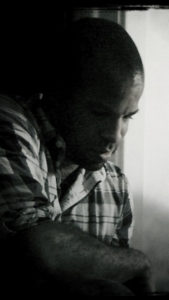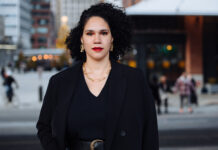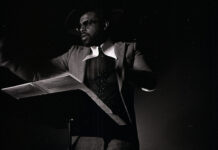The opera Sweet Land, from Yuval Sharon’s The Industry, is a two-part work that examines race in America, the taking of land from indigenous people, the definition of being an immigrant and the responsibilities of settlers. It is a bold work that has earned rave reviews for composers Du Yun and Raven Chacon and their librettists Douglas Kearney and Aja Couchois Duncan.
While the tagline for Sweet Land is “an opera that erases itself,” Kearney and Duncan had more than that on their mind as they structured the two-parts: Feast and Train. (For full details of the opera please go here.) Not only are there two parts to the opera, there are two parts to Feast and Train.
Kearney wrote the second part of Feast and the first part of Train. Duncan wrote the first part of Feast and the second part of Train. But the librettists had more than just the idea of an opera erasing itself on their minds as I learned when I spoke by phone last week with each of them.
Here is part one of my conversations with the two writers. These excerpts from those conversations have been edited for length and clarity.
The timing of Sweet Land seems perfect given the present administration’s treatment of immigrants. How much did Trump’s policies influence the creation of this work and the writing you did?

ACD: My understanding is the 2016 election had a really profound impact on Yuval personally and that was a large piece of his impetus of wanting to do the original version and then the struggle to fund it through to what we have.
One of the things that in response to his draconian immigration practices is a refrain that people say all the time which is wrong which is “We are all immigrants.” We are not all immigrants. The complexity and nexus of those things was of particular interest for Douglas and I.
DK: One of the things that’s interesting about that line is how it has been imagined as a unifying rallying call. But in that usage there is an erasure that is maybe well-meaning, but is persistent erasure because the indigenous people are not immigrants. That exclusion is central to the American myth.
There is a way in which immigration is imagined as a kind of intentional seeking of a better life. From an Afro-dysphoric perspective, at least some populations of it, I don’t know you can call it immigration.
When creating art that has a strong political component, are you preaching to the converted or do you think that concept itself reflects a naivete that would suggest there’s not racism to be found amongst the arts crowd?

DK: That’s such a great question. I think there was definitely a time period in which I was really worried about preaching to the converted. During the process I had to think about what I was arguing for in terms of representation and space myself as one of the creators. Even in delivering political commentary there is a way people can come expecting a particular kind of response or treatment. So trying to destabilize that and make things less streamlined is one of the ways I try to approach political content.
ACD: There was an operating assumption that the largest percentage of the audience would be white and older based on the demographics of The Industry’s opera audience. However, because all of the creative folks with the exception of Yuval were people of color and we were focused on bringing in people of color, we were not writing in opposition to white imagination or something. I think we were hoping we would affirm things that resonate with people’s experience; jar folks who aren’t as experienced with the experiences of the audience.
It seems to me that Sweet Land reaches two segments of the audience: those who are determined to break the cycle of bigotry and those who repeat it. What would you like each group to get from their experience of seeing Sweet Land?
ACD: One of the things that we were doing in sort of an explanation for the second act for Train and Feast was to evidence ways in which erasures of history are present. Speaking for myself as a mixed race, cisgender queer woman, there’s all kinds of way I don’t write things that I’m tacitly implicit in or just don’t literally see because I don’t see the breadth of them because of my skin, or mixed race or higher education. All of us, regardless of what we are trying to do, can always increase the volume of our awareness.
DK: For people who would like to break the cycle, I would like people to come away from it not feeling as though they have been necessarily given an answer as much as they have been given a method for destabilizing and working through the questions and the problem.
ACD: For folks that don’t care, if they don’t care you can’t speak to them. They need some cataclysmic life event and even that might not change their world view. I’m not sure that people who don’t care were ever our audience. People who are more comfortable not having to care, it’s probably those folks we are hoping we can be in a dialogue with. It’s a presenting of an experience so that hopefully they no longer feel they can’t care.
DK: It’s a difficult game to presume that what a person who is dead-set against recognizing the humanity of other people that what they need is just the right argument. That strikes me that it is the job, often times, of the victims to not be victimized. I don’t know that in the great history of political speech or artistic effort that the goal should be “maybe if I write this one line, that person will go ‘Oh.'” That’s giving them the right to abdicate responsibility. I don’t know that’s the rubric we should be using.
For someone in the 21st century to say they haven’t encountered humanity from other people that are not like them, if they come to Sweet Land, I hope what they see is opera in which you have a group of artists who have created a work of art using an approach while, on the outside it might look like it is consistent with other kinds of productions, but that it was created with an approach of consensus that is more consistent with a sense of community. That it took discipline and that took effort, but was what was central to creating this work that is Sweet Land.
Check back soon for part two of my interview with Aja Couchois Duncan and Douglas Kearney.
Main photo: An image from Feast 2 in Sweet Land (Photo by Casey Kringlen for The Industry) All photos courtesy of The Industry











